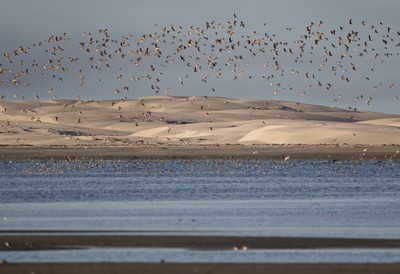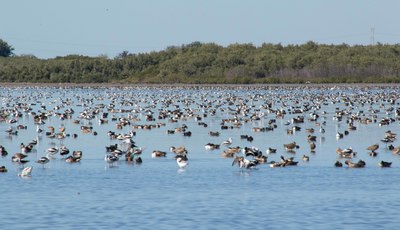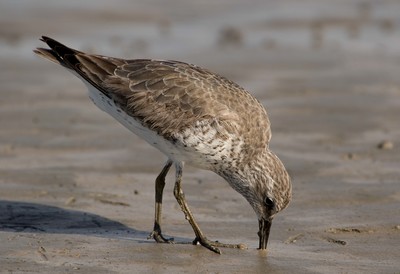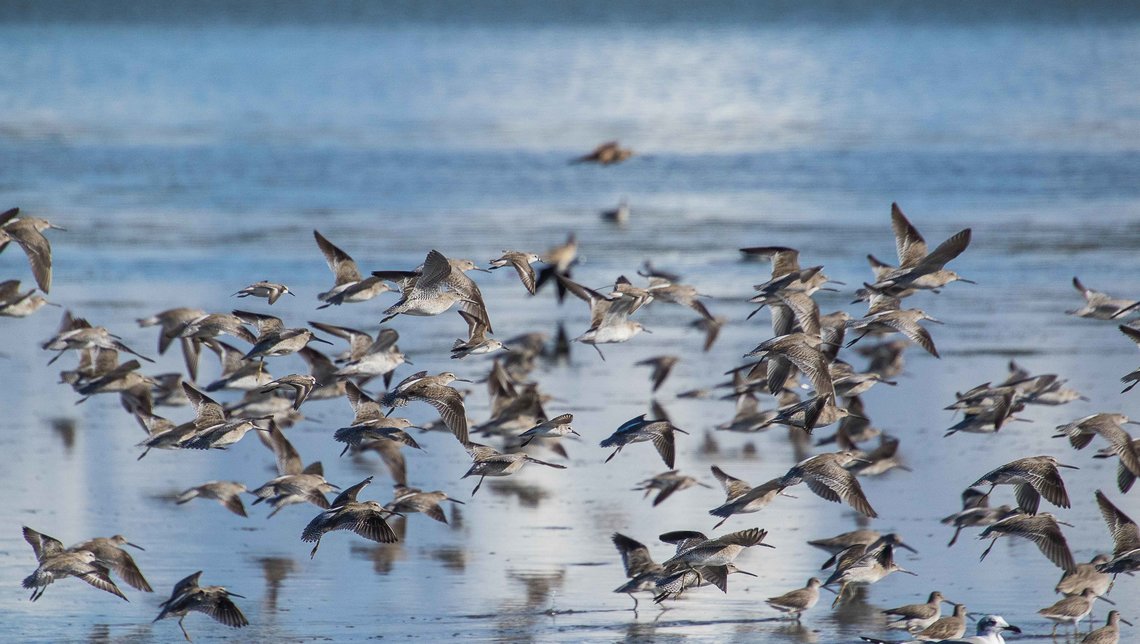By Julián García Walther, PhD student, University of South Carolina
The rocky Alaskan tundra may not seem intuitively linked to the warm coasts of the Sonoran Desert more than 6,000 kilometers away, but for Red Knots (Calidris canutus roselaari)—a shorebird that breeds during the summer in the Arctic—these links have existed for thousands of years. When fall migration starts, recently fledged birds embark on a solo journey over oceans and coastlines that they have never seen before. Their destination: the beaches and wetlands of northwest Mexico.

One of their first and most important stops is in the heart of the Baja California peninsula: the Guerrero Negro and Ojo de Liebre lagoons. During the winter, this 160,000-hectare wetland complex surrounded by an arid and sparsely vegetated landscape hosts more than one third of the global population of roselaari Red Knots, Short-billed Dowitchers (Limnodromus griseus caurinus) and Marbled Godwits (Limosa fedoa). Because human densities are so low here, shorebirds can forage in the extensive intertidal mudflats and marshes without disturbance. Additionally, 30,000 hectares of nearby shallow water evaporation salt ponds, built by the world’s largest salt works, offer a rare example of how shorebirds and industry can coexist.
While Guerrero Negro offers high quality and low disturbance habitat for thousands of shorebirds, this and many other stopover sites in northwest Mexico face a looming threat: sea level rise. Scientists predict that sea levels may increase 0.3—1.2 m by the end of the century. For shorebirds, this could mean that the low-lying intertidal mudflats and beaches on which they depend for foraging and roosting may be lost.
How will shorebirds respond to these alterations to their non-breeding habitat?
With this question in my mind, I packed scopes, maps, and camping gear in my vehicle and embarked on a trip to survey dozens of coastal wetlands from Sonora to Nayarit. One of the goals of my dissertation was to understand how sea level rise might affect critical sites for Red Knots.
Red Knots not only use wetlands on the Baja California peninsula, they also use a variety of coastal habitats on mainland Mexico, possibly as steppingstones to sites of greater importance. But as I traveled the coast, finding them proved challenging. In Sonora, many remote locations have limited road access, a problem made worse in Sinaloa by dense vegetation and mangroves. For shorebirds, this is good news because the region offers plenty of undisturbed habitat compared to more populated sites where coastal development, aquaculture, and other pressures have degraded habitat.

A small fishing town at Bahía de Ohiura, Sinaloa exemplified the importance of these wetlands for migratory birds. Here, more than 50,000 waterbirds lined up along the six-kilometer long bay. This included 15 species of shorebirds frantically probing the mud and, to our delight, at least 500 Red Knots. Many of them had flags on their tibias revealing that researchers had banded them in Grays Harbor, Washington and Nome, Alaska. Perhaps the most exciting find was a Red Knot whose flag code read 1ML. This code belonged to a chick my colleagues and I had banded the previous summer in Alaska. At less than one year old, a bird the size of a grapefruit had just completed a 6,000 km migration to reach this site!
For the sites important to shorebirds, the future is uncertain. Our preliminary results indicate that 37% of the locations where Red Knots occur along the coast of northwest Mexico overlap with areas that are predicted to be flooded by 2050 by rising sea levels. For bays like Bahia de Ohiura, rising seas may reduce the available habitat and ecosystem services on which shorebirds and coastal human communities rely. Now more than ever, we need ecosystem-based solutions that both protect coasts and conserve shorebird habitat coastal.

As winter turns to spring, Red Knots are beginning to store energy and gain weight like a vehicle filling its gas tank. Their dull gray coloration typical of the non-breeding grounds will turn bright terracotta orange and finally, when the condition are right, they begin the journey north to their breeding grounds that for millennia has bound the Sonoran Desert coast with the Arctic.
As for me, I hope that my journey as a researcher leads to solutions that can address the myriad challenges facing shorebirds and our coast in light of global change.
This research was possible thanks to the financial support and advice of the Senner Lab. I thank Pronatura Noroeste, Laboratorio de aves (UABCS), and Coastal Solutions Fellow Jonathan Vargas for their knowledge and support.

